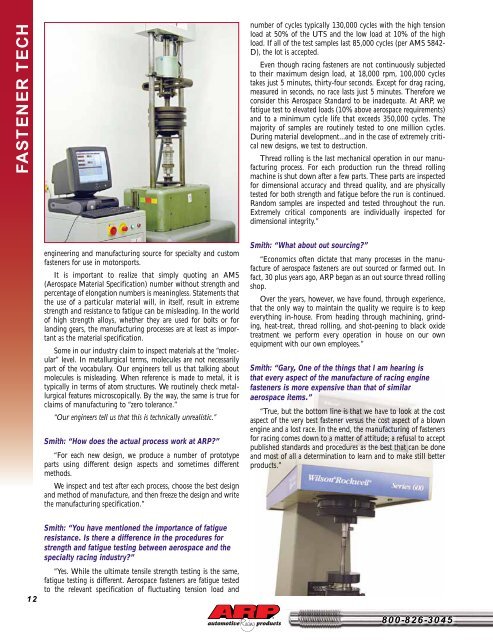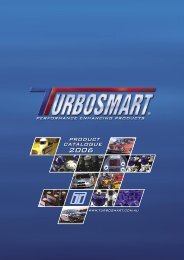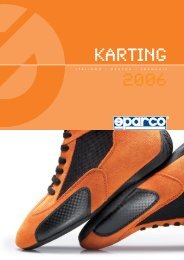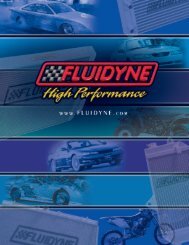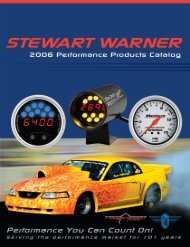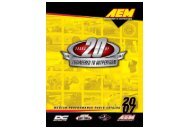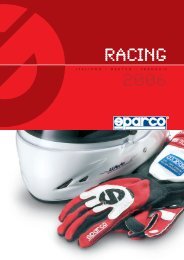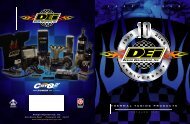Catalog Supplement for 2006 - JRP
Catalog Supplement for 2006 - JRP
Catalog Supplement for 2006 - JRP
Create successful ePaper yourself
Turn your PDF publications into a flip-book with our unique Google optimized e-Paper software.
FASTENER TECH<br />
number of cycles typically 130,000 cycles with the high tension<br />
load at 50% of the UTS and the low load at 10% of the high<br />
load. If all of the test samples last 85,000 cycles (per AMS 5842-<br />
D), the lot is accepted.<br />
Even though racing fasteners are not continuously subjected<br />
to their maximum design load, at 18,000 rpm, 100,000 cycles<br />
takes just 5 minutes, thirty-four seconds. Except <strong>for</strong> drag racing,<br />
measured in seconds, no race lasts just 5 minutes. There<strong>for</strong>e we<br />
consider this Aerospace Standard to be inadequate. At ARP, we<br />
fatigue test to elevated loads (10% above aerospace requirements)<br />
and to a minimum cycle life that exceeds 350,000 cycles. The<br />
majority of samples are routinely tested to one million cycles.<br />
During material development...and in the case of extremely critical<br />
new designs, we test to destruction.<br />
Thread rolling is the last mechanical operation in our manufacturing<br />
process. For each production run the thread rolling<br />
machine is shut down after a few parts. These parts are inspected<br />
<strong>for</strong> dimensional accuracy and thread quality, and are physically<br />
tested <strong>for</strong> both strength and fatigue be<strong>for</strong>e the run is continued.<br />
Random samples are inspected and tested throughout the run.<br />
Extremely critical components are individually inspected <strong>for</strong><br />
dimensional integrity.”<br />
engineering and manufacturing source <strong>for</strong> specialty and custom<br />
fasteners <strong>for</strong> use in motorsports.<br />
It is important to realize that simply quoting an AMS<br />
(Aerospace Material Specification) number without strength and<br />
percentage of elongation numbers is meaningless. Statements that<br />
the use of a particular material will, in itself, result in extreme<br />
strength and resistance to fatigue can be misleading. In the world<br />
of high strength alloys, whether they are used <strong>for</strong> bolts or <strong>for</strong><br />
landing gears, the manufacturing processes are at least as important<br />
as the material specification.<br />
Some in our industry claim to inspect materials at the “molecular”<br />
level. In metallurgical terms, molecules are not necessarily<br />
part of the vocabulary. Our engineers tell us that talking about<br />
molecules is misleading. When reference is made to metal, it is<br />
typically in terms of atom structures. We routinely check metallurgical<br />
features microscopically. By the way, the same is true <strong>for</strong><br />
claims of manufacturing to “zero tolerance.”<br />
“Our engineers tell us that this is technically unrealistic.”<br />
Smith: “How does the actual process work at ARP”<br />
“For each new design, we produce a number of prototype<br />
parts using different design aspects and sometimes different<br />
methods.<br />
We inspect and test after each process, choose the best design<br />
and method of manufacture, and then freeze the design and write<br />
the manufacturing specification.”<br />
Smith: “What about out sourcing”<br />
“Economics often dictate that many processes in the manufacture<br />
of aerospace fasteners are out sourced or farmed out. In<br />
fact, 30 plus years ago, ARP began as an out source thread rolling<br />
shop.<br />
Over the years, however, we have found, through experience,<br />
that the only way to maintain the quality we require is to keep<br />
everything in-house. From heading through machining, grinding,<br />
heat-treat, thread rolling, and shot-peening to black oxide<br />
treatment we per<strong>for</strong>m every operation in house on our own<br />
equipment with our own employees.”<br />
Smith: “Gary, One of the things that I am hearing is<br />
that every aspect of the manufacture of racing engine<br />
fasteners is more expensive than that of similar<br />
aerospace items.”<br />
“True, but the bottom line is that we have to look at the cost<br />
aspect of the very best fastener versus the cost aspect of a blown<br />
engine and a lost race. In the end, the manufacturing of fasteners<br />
<strong>for</strong> racing comes down to a matter of attitude; a refusal to accept<br />
published standards and procedures as the best that can be done<br />
and most of all a determination to learn and to make still better<br />
products.”<br />
12<br />
Smith: “You have mentioned the importance of fatigue<br />
resistance. Is there a difference in the procedures <strong>for</strong><br />
strength and fatigue testing between aerospace and the<br />
specialty racing industry”<br />
“Yes. While the ultimate tensile strength testing is the same,<br />
fatigue testing is different. Aerospace fasteners are fatigue tested<br />
to the relevant specification of fluctuating tension load and<br />
800-826-3045


